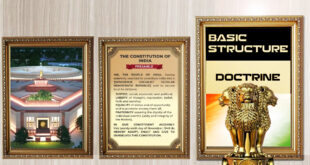It spells double danger — threatening India’s secular and democratic standing and miring the economy deeper in crisis
Hindutva “nationalism” unlike anti-colonial nationalism does not comprehend economics. The reason is simple. Central to anti-colonial nationalism was an understanding of colonial exploitation. This is why it distinguished between all previous rulers and the colonial rulers: previous rulers had appropriated economic surplus from the peasantry and spent it domestically, thereby generating employment; colonialism expropriated surplus from the peasantry and shipped most of it abroad which destroyed domestic employment. Hindutva obliterates this basic distinction, putting the Mughals and the British on a par, because it does not comprehend economics.
A discourse shift
This ironically has been its forte. In a period in which neo-liberal capitalism has lost its steam, the corporate-financial oligarchy wants an ideological prop different from the one it had used earlier, namely the promise of a high GDP growth and its potentially beneficial effect for all. This no longer suffices when growth slackens. Orienting state policy in favour of this oligarchy and yet preventing any revolt from below requires a discourse shift, which Hindutva provides. This is the basis of the formation of the corporate-Hindutva alliance which currently rules the country. Had Hindutva been more economics-savvy and attempted to tinker with the economic regime to overcome the crisis that has arisen essentially because of the contradictions of neo-liberalism (though aggravated by blunders such as demonetisation and the Goods and Services Tax, or GST), its usefulness to the corporates would have been limited. This alliance would have got ruptured. But Hindutva’s ignorance in economic matters has stood it in good stead vis-à-vis the corporates; and the alliance continues. This shift of discourse is from one bequeathed by the anti-colonial struggle, where political formations vied with one another in projecting the relief they promised to the people, to one of hyper-nationalism that has little in common with anti-colonial nationalism, and largely sidesteps the material conditions of life of the people. It harks back rather to a European hyper-nationalism that reached its culmination during the inter-war years. The importance of this discourse shift was clearly manifest during the recent Lok Sabha elections. The Bharatiya Janata Party had lost ground prior to it; and a powerful peasant movement was building up threatening its continuance in power. But Pulwama and the Balakot strike, strengthening the hyper-nationalist discourse, gave it a fresh lease of life. The same peasants, who had marched against the government in Delhi just days before the elections, voted for its continuance. The usefulness of this discourse shift to the corporate-financial oligarchy is obvious from recent developments. In the lee of the dilution of Articles 370 and 35A, which amounts to a forcible annexation of Jammu and Kashmir and which stokes Hindutva hyper-nationalism, the government has introduced corporate tax concessions worth Rs. 1.45 lakh crore, ostensibly to overcome the economy’s crisis. Whatever opposition one would have normally expected to this gratuitous transfer of public funds to corporate pockets, is drowned out in the din of hyper-nationalism celebrating the “triumph” in Kashmir. The fact that this tax-concession will have a negative effect on the level of activity in the economy, and hence on employment and output, though obvious, is scarcely articulated. Since the tax-concession will not be financed by a larger fiscal deficit, as that would alienate globalised finance capital which the government is loath to do, it will have to pinch resources from the working people. Any income-shift from the working people to the corporates, however, ceteris paribus reduces consumption demand in the economy. This is because the propensity to consume out of income is higher for working people than for corporates who keep their extra income partly as undistributed profits; even out of the dividends distributed out of such extra income the propensity to consume is low. And since corporate investment depends on the expected growth in the size of the market, which a rise in the current post-tax profits does not change an iota, there will be no additional investment that would be caused by such tax concessions. Hence the overall aggregate demand will decline, worsening the crisis. What is more, with such a decline in aggregate demand, investment in the next period will decline, accentuating the downward spiral of the economy. This crisis itself has been caused by the enormous increase in income inequality that neo-liberal capitalism has brought about, not just in India but the world over. It has shifted incomes from the working people, namely peasants, workers, artisans, craftsmen, and fishermen, towards the corporate-financial oligarchy. The demand-contracting effects of this shift had been offset for long by a set of contingent factors, mainly asset price bubbles, both in India and globally. But with the decline of such factors, the crisis has manifested itself, with Narendra Modi’s demonetisation and GST only compounding the problem arising from the structural infirmity of neo-liberal capitalism. And now the government’s solution to the crisis is to further shift incomes from the working people to the corporates which caused the crisis in the first place.
But as long as the government succeeds in keeping alive the Hindutva hyper-nationalist discourse, it can manage to divert attention from its economic mistakes. The real question is: how did it succeed in marketing its hyper-nationalist discourse? While there are multiple reasons for it, one must not underestimate the pervasive inculcation of fear and insecurity in the minds of the people. Any criticism of the government, or any presentation of the other side of an argument, brings in charges of “sedition”, anti-nationalism, and belonging to the “tukde-tukde” gang, with little relief from the judiciary which typically follows the executive; political opponents are threatened by the Enforcement Directorate and the Central Bureau of Investigation for alleged financial misdemeanours; and then there is the army of “trolls” and hoodlums that can be unleashed on anyone, with the police generally looking the other way. In this context, and given the virtually complete capitulation of the media to the project of Hindutva hyper-nationalism, only one side of the picture gets presented; not surprisingly this side is taken by many as the truth.
A camouflage
The counter-productiveness of following a pro-corporate and anti-working people income distribution strategy in the midst of a crisis caused by inadequate aggregate demand, will become apparent over time; but this will only spawn even greater Hindutva hyper-nationalist mega projects. The idea is to “shock and awe” people in order to distract attention from the economy and camouflage the government’s economic failures. This however entails a double danger to the country. The Hindutva hyper-nationalist “shock-and awe” mega projects, such as “one country-one language”, or a National Register of Citizens for the country as a whole, or the Citizenship Amendment Bill, pose a threat to our very existence as a secular and democratic society and polity; at the same time the pro-corporate and anti-working-people economic policies would mire the economy deeper in crisis. Since such economic policies stimulate the “shock-and-awe” projects, the country is caught in a vicious dialectic which will continue until the tide turns.
Check Also
Joint Parliamentary Committees (JPCs): Scrutinizing the Executive
Introduction In a parliamentary democracy, ensuring accountability of the executive is paramount. Joint Parliamentary Committees …
 Chinmaya IAS Academy – Current Affairs Chinmaya IAS Academy – Current Affairs
Chinmaya IAS Academy – Current Affairs Chinmaya IAS Academy – Current Affairs



